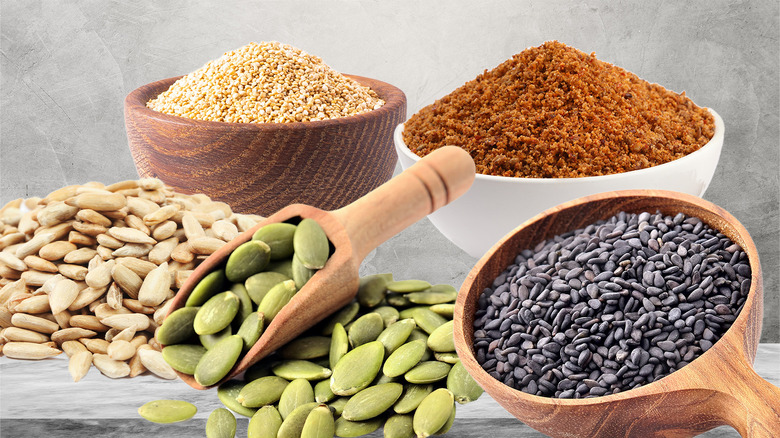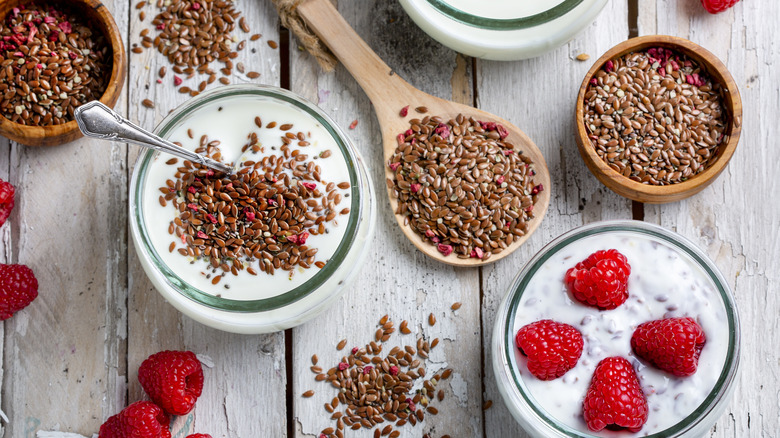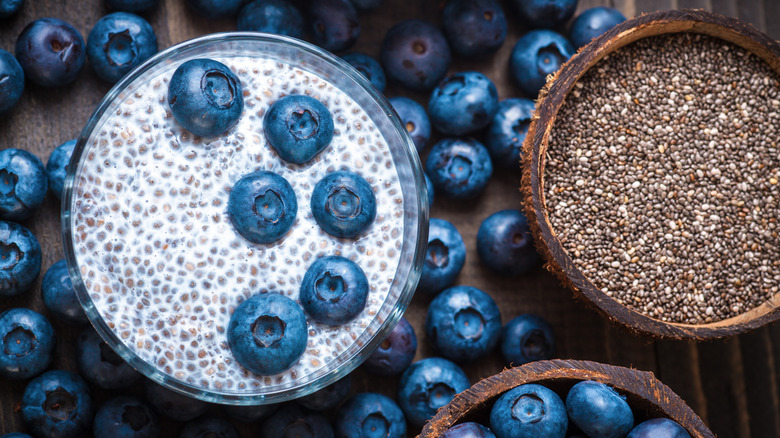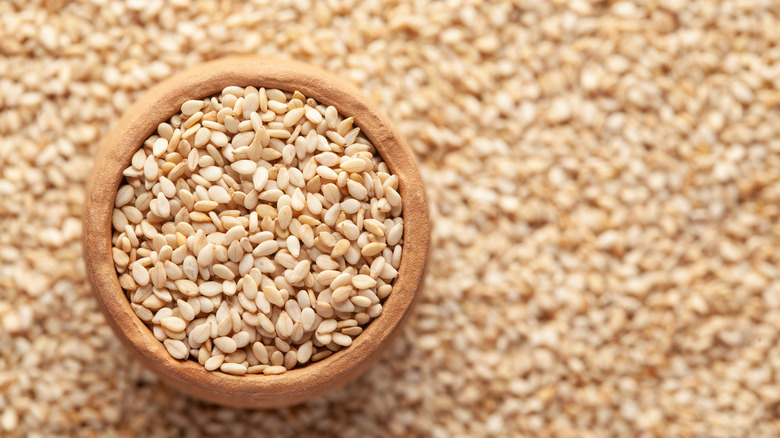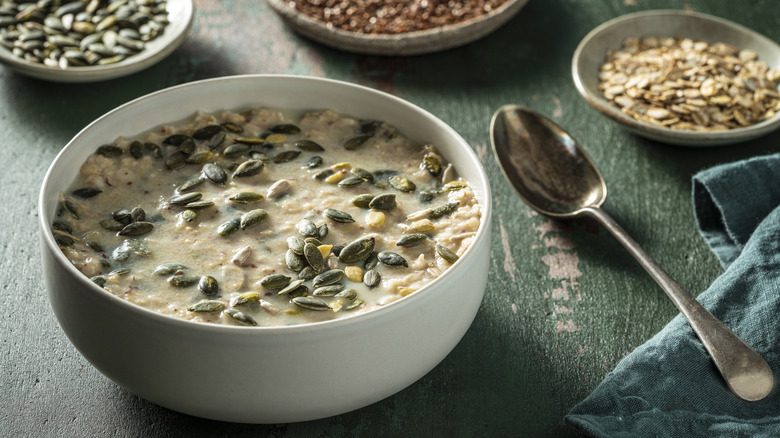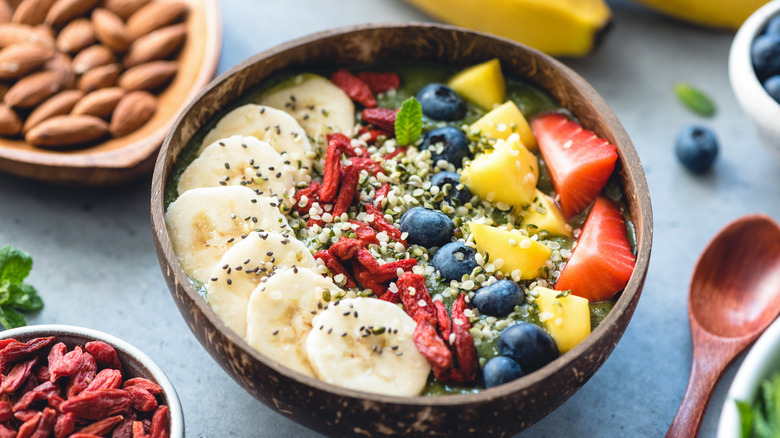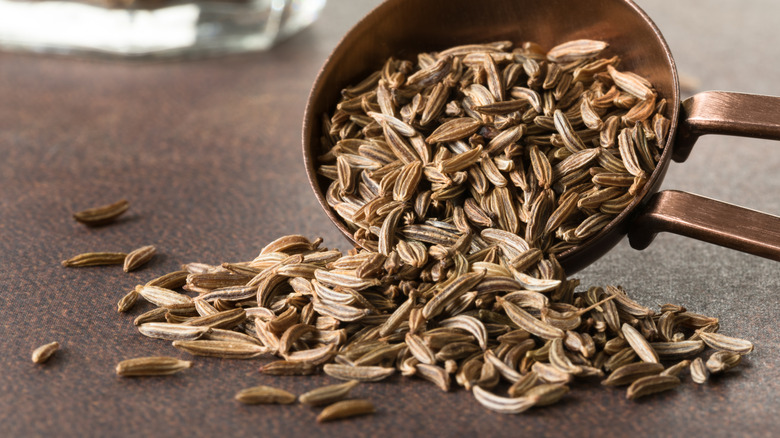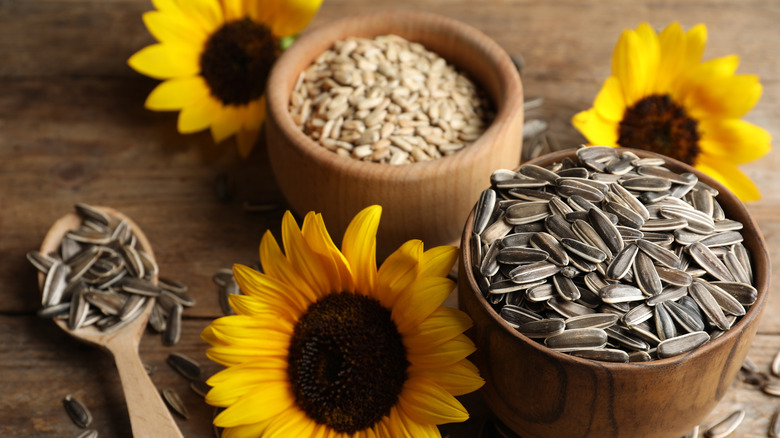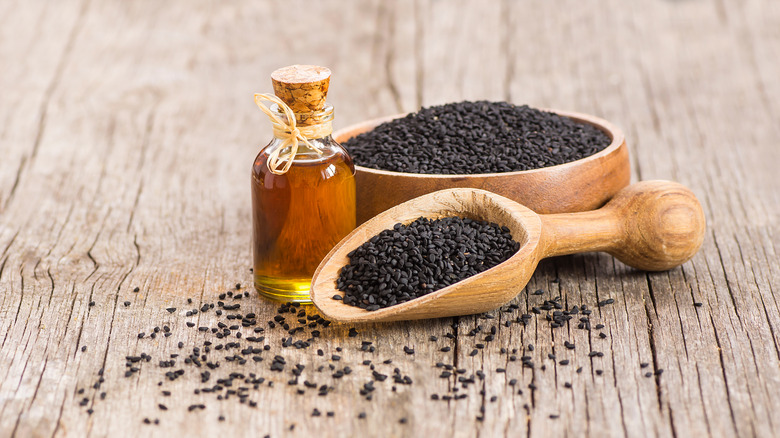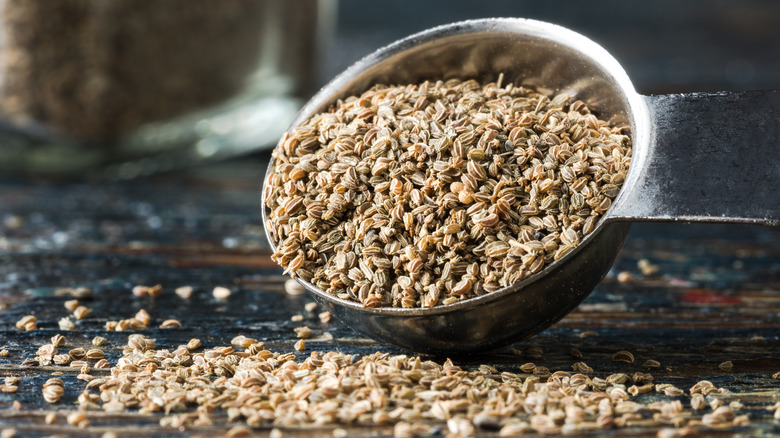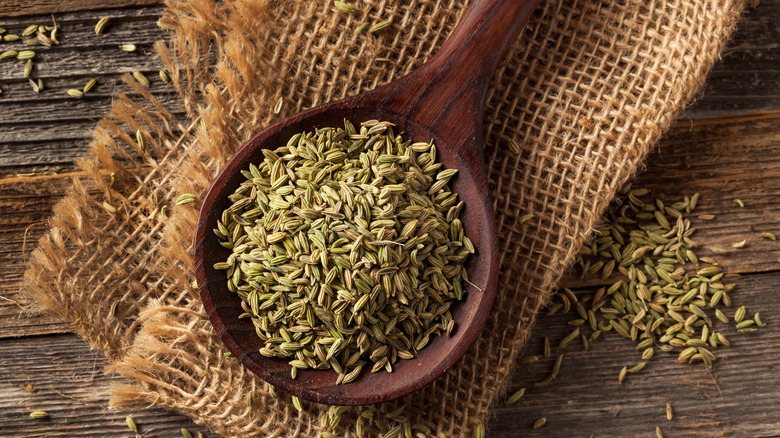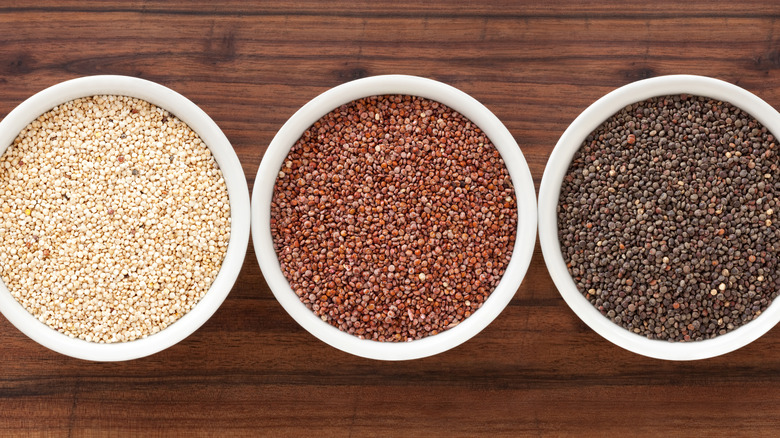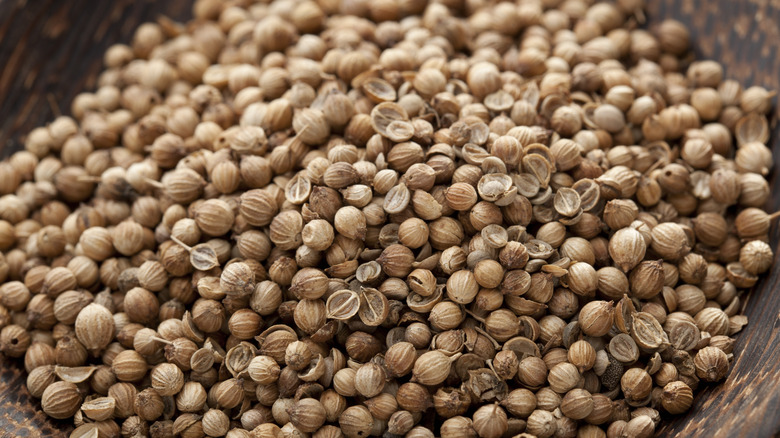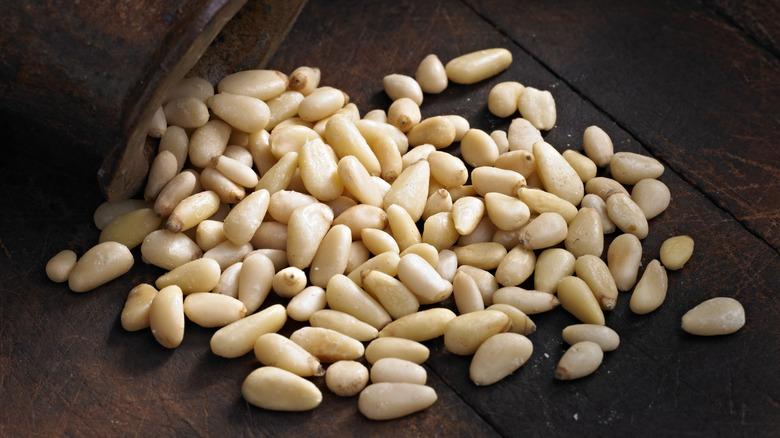14 Seeds You Should Be Cooking With
There are quite a few distinctions that make elite cooks stand out from the rest. One of the most important elements found in fine dining is contrast, whether that be in temperature, flavor, or texture. There are several ways to achieve varied textures, one of them being how the food is prepared. As we all know, frying and crisping can add an irresistible mouthfeel to almost any dish, but another way to get there is with the use of naturally crunchy foods like seeds. Most home cooks consider which proteins, grains, and vegetables to incorporate into their daily dishes, but seeds often go overlooked.
Not only do they add texture, but seeds often have subtle yet distinctive flavors that can make a meal pop. In addition, they add visual texture as a garnish and can make even a scoop of white rice go from boring to exciting. When it comes to seeds, there is no shortage of diversity. If you're new to the seed game, there are a number of starter seeds that you should be cooking with. Let's get started.
Flaxseed
One of the healthiest and most popular seeds currently in the U.S. is flaxseed. And it's no wonder Americans are stocking up on it. Flax is high in fiber, which 97% of Americans are deficient in, per Nutrition Facts. Fiber helps to get things moving and creates a balanced gut microbiome by giving good bacteria something to feed on. This sends a good vibe to the rest of the body, producing better mental health, a healthier cardiovascular system, and even a heightened immune response. So how exactly do you go about using this golden seed in day-to-day life?
For starters, flaxseed is best consumed freshly ground, at which point it becomes flax meal. It can be eaten raw or toasted for a stronger nutty flavor. Flax can be a topping for both savory and sweet dishes like salads or yogurt. When in doubt, toast up some flax seeds for a versatile crunchy topping.
It can also be used in baking as a healthy egg replacer. Simply mix one tablespoon of ground flax meal with three tablespoons of warm water and wait for about 10 minutes until the flax has had time to absorb the liquid. You'll notice it's taken on the consistency of an egg and makes for a great binder in muffins, cookies, pancakes, and even bread.
Chia
Do you remember chia pets from the '80s? Those clay structures that grew a mane of grassy hair when watered? Well, the seeds responsible were chia seeds. Besides making for a nostalgic decoration, chia seeds are gaining back popularity, this time as a food in the United States. They come in several varieties, don't have much flavor, and look like poppy seeds. Like flax, they can be used as an egg replacer when cooking with chia seeds, and they contain quite a bit of fiber, as well as protein, and Omega 3s, per the USDA. Chia seeds have a unique ability. When soaked in water, they swell up to several times their size and resemble frog eggs. Their slimy texture is something you're either going to love or hate, but the vegan community has been quick to harness this superpower to make plant-based pudding.
Beyond pudding and pancakes, chia seeds can be used to add texture to just about anything. Sprinkle them on your salad or oatmeal, or blend them right into a smoothie. Beware though, don't consume raw chia seeds without adequate liquid. If hydration is an issue, consider making a homemade goo-pack for your athletic endeavors. Simply mix chia seeds with lime juice, maple syrup, and water and let it all sit overnight until it's a drinkable mass. Slowly sip during your next run or tennis match for ultimate energy and stamina.
Sesame seeds
There's no doubt you've enjoyed sesame seeds on a bagel or plastered to the outside of your sushi roll at least once in your life. Because they are rather subtle in flavor, you may not be able to pinpoint the exact taste, but when toasted, sesame seeds can carry their own tune. In fact, at one point in time, sesame seeds were deemed as valuable as gold. During the Middle Ages, they were an important part of the spice trade that connected the world through the exchange of goods and were just as valuable as the precious yellow metal.
Sesame seeds can be used to crust tofu or eggplant and give it that crispy crunch, especially when fried. Use the seeds in any Asian or Middle Eastern dish flawlessly. Sesame seed lovers may find their new favorite sauce to be tahini, which is simply ground sesame seeds. Even if you've never heard of it, it's likely you've tried it in hummus. It's nutty, slightly bitter, and quite creamy. Whip it with water and enjoy it over a salad, steamed sweet potato, or falafel.
Pumpkin seeds
Every year there's a horror that takes place on October 30, and we aren't talking about Halloween. Millions of pumpkin seeds are tossed into the compost when eager kids and parents carve their very own jack-o-lanterns. Instead of throwing away those precious seeds, toast them to make a healthy, savory, or sweet snack. If the fibrous outer layer of the pumpkin seed is a little too much for your teeth to handle, try squeezing out the green inner seed called a pepita.
Simply roast the seeds with a little oil and seasoning. Look up a pumpkin seed or experiment with your favorite spices. Think of flavoring these seeds as you would popcorn. Go savory with salt, pepper, paprika, and garlic powder, or choose something that aligns more with the pumpkin spice season and opt for cinnamon, sugar, and salt. These seeds can be eaten as a protein-rich healthy snack or sprinkled on salads, soups, or proteins for added crunch and flavor.
Hemp seeds
Hemp seeds are famous in both the vegan and athletic communities for their high protein content, subtle flavor, and chewy texture. These components make it an incredible protein booster without changing the flavor of whatever you making, which is why it's an easy way to add more hemp seeds to your diet.
While hemp seeds are less popular than hemp hearts, they do contain more fiber as they are the un-hulled part of the help seed. Hemp hearts, the little flakey green and white bits that you often find at the grocery store, are quite nutritious themselves. They are easy to digest, more subtle in flavor, and quite tender and chewy. They are easy to add to salads, smoothies, oatmeal, pancakes, and baked goods. You can even pop a handful in your mouth for snacking on the go, or try adding it to your trail mix to make sure you have enough protein to recharge.
Poppy seeds
Poppy seeds are famous for their classic pairing with lemon-flavored baked goods or bagels, but they have a much wider range. Eastern Europeans, in fact, use them in a variety of dishes from poppy seed stuffed cake to poppy seed bread pudding. The reason poppy seeds are beloved across Eastern Europe is that they symbolize wealth and prosperity, which is why they make a dominant appearance around the New Year.
These little black seeds are quite flavorful, with nutty undertones and a pleasing crunchy texture. They can be eaten raw or sprinkled on just about anything, but tend to pair well with bread and sweet treats. Salad dressing hosts the seed well, especially those with fruity flavors, as they add some texture to the mix. But, if you're starting a new job and are about to take a drug test, beware. Although the little seeds don't contain nearly enough opioid properties to intoxicate you, even in large quantities, they may produce a positive result on a drug test per The University of Florida Health. Blaming a muffin for a positive opioid result isn't a great look, so better to avoid them altogether until you've passed.
Caraway seeds
Caraway seeds are often confused with both fennel and cumin but they are actually quite different. However, because of the subtle similarities, caraway seed is often referred to as meridian fennel or Persian cumin. The little seeds that look quite similar to fennel seeds have an anise flavor with pepper and citrus undertones. You may have enjoyed the flavorful seeds on rye bread in the past, but there are plenty of ways to use them in everyday cooking.
One way to enjoy caraway seeds is mixed into potato salad or coleslaw. The pockets of strong flavor will help create a distinctive side dish while complementing the creamy coolness of the recipe. Caraway seeds are also often used in soups and broth to add depth and flavor, as well as on homemade crackers or croutons. Roasted carrots are complemented by the addition of caraway seeds, as are other vegetables and robust and flavorful proteins. And don't forget about the small seeds in your dessert! Caraway seeds can be added to shortbreads and cookies to give them a unique flair.
Sunflower seeds
While it may feel like the U.S. and Italy are scattered with sunflower farms, most of the world's sunflower seeds actually come from Russia and Ukraine. In fact, much of the countryside is plastered with beautiful, deep yellow fields ready for harvesting and export. However, getting domestically grown seeds is easy to do.
Although most seeds are enjoyed as a complementary part of a dish, sunflower seeds are quite often enjoyed on their own as a snack. In fact, you can buy them salted in the shell and chew them free yourself. If you'd prefer to incorporate them into your cooking, then you're in luck, because sunflower seeds are just subtle enough in flavor to hide their way into any dish while adding richness and texture.
Often, sunflower seeds are found sprinkled on freshly baked bread, which can add an element of chewiness to the crust. They can also be sprinkled on salads and grain bowls, and are often found topping vegetable soups like tomato or roasted red pepper bisque. Consider rolling them into energy bites or adding them to your morning granola for a little protein boost. Sunflower seeds can also be made into sun butter, which is similar to peanut butter but can be a more allergen-friendly option.
Nigella seeds
Nigella seeds, also known as black cumin, are not a common kitchen spice in the United States. However, they should be because of their versatility and delicious flavoring. Nigella seeds are deep black and have an almost herb-like, oniony flavor to them. So, for those who enjoy onion powder and onion flakes, consider purchasing some black cumin to add to your spice cabinet.
Although you'll find them primarily in Indian and Asian cooking, nigella seeds can be used to help boost the flavor of your everyday staples. Sprinkle them on homemade bread, mix them right into your salad or dressing, and load up your sandwich with the delicious oniony seeds. Enjoy them ground up or toast them in a hot, dry pan until fragrant for a more intense flavor.
Nigella seeds have traditionally been used in various cultures for medicinal purposes, including to treat chronic pain, airway disorders, headaches, hypertension, and more. The National Library of Medicine believes this is because of their high antioxidant and anti-inflammatory properties, which makes these little black seeds more than just a tasty treat.
Celery seeds
It should be no surprise that celery seeds taste quite a bit like celery itself, only a little earthier and slightly bitter when ground. That means it has that sodium-rich, fresh flavor that we love about celery, only concentrated into little dry seeds. Be sure that you're purchasing celery seeds instead of celery salt if you want to regulate how much salt you're adding to your dish, as celery salt has quite a bit more sodium.
You can use celery seeds for just about any recipe you'd consider adding celery to. Consider using them for chicken and chickpea salads, egg salad, seafood salad, potato salad, lobster rolls, and even salad dressing. The seeds also flavor soups beautifully and pair well with parsley and dill. Top grilled fish or meat with the spice, and don't forget to add a tablespoon or so to your homemade pickling recipes. Or add celery seeds to steamed carrots and sautéed onions for a quick and healthy side dish.
Fennel seeds
While fennel seeds are most famous for flavoring Italian sausage, there are plenty of ways to use them to enhance other dishes. Fennel seeds taste quite a bit like licorice and have a strong flavor and scent, so it's best to use them in moderation. They have sweet undertones and a lasting smooth aftertaste. The seeds themselves are chewy and can be used either whole or ground up into a powder. Toasted, fennel seeds have a more intense flavor and can become quite aromatic.
While fennel seeds can boost any sauce, curry, soup, or salad dish, they also play nicely with sweet dishes like fennel cake, fennel panna cotta, and tea cookies because of their licorice notes. In fact, fennel tea is quite popular as an after-dinner digestive aid, as fennel seed helps to stimulate digestive juices, per the National Library of Medicine. Fennel tea is used around the world and has been for hundreds of years for this exact purpose.
Quinoa
I know, we were surprised too: Although quinoa has been masquerading around as a grain, it's actually a seed. But if you really think about it, when cooked, the little seeds produce those funny tails, which are actually the nutritious germ of the seed. There are plenty of other hidden tricks up the seed's sleeves that could expand your horizons in the kitchen considerably. Instead of simply boiling quinoa in water and enjoying it in a grain bowl or on a salad, venture into a few new cooking approaches.
Quinoa can be toasted right in a dry pan or toaster oven. Do this with raw quinoa that has not been cooked to produce a nutty, toasty, seed-like flavor. These crunchy bits can be added to salads, used to top homemade bread, or even sprinkled over oatmeal for added texture. In addition, raw quinoa can be ground together with water to produce a batter that can be baked into a pizza crust. This is the simplest gluten-free crust out there. It's simply a 1:1 ratio of raw quinoa to water processed in a high-speed blender until smooth. Use a rubber spatula to smear it out on parchment paper to the desired shape, and bake at 400 degrees Fahrenheit for 20 minutes. Then flip it and continue baking for about 10 minutes, or until the crust looks crunchy and begins to brown. Top with your favorite ingredients and bake again.
Coriander seed
While typically you will find coriander seeds ground, they are actually quite pleasing in their whole form and have a slightly different flavor profile. In fact, whole coriander seeds have a similar floral taste to cardamom, along with the classic citrusy sweet curry flavor of the ground version. The little seed pods almost look like small nuts, and come from the cilantro plant. When toasted, coriander seeds become quite nutty and fragrant, which is how it's recommended to be cooked if it's going to be used in its whole form. You can dry roast them by using a hot, dry pan. The trick is to keep them consistently moving and to remove them from the pan the moment they begin to become toasty brown. You can also use a little oil to fry them slightly.
Whole pods work well in rubs and chutneys, while ground coriander seed works better as an integrated part of a dish. When cooking with coriander seeds, note that they can be used in both sweet and savory dishes, although they typically appear most in the latter. In fact, coriander gelato, coriander tea, and coriander seed bunt cakes are all quite delicious and unique.
Pine nuts
Although their name might be misleading, pine nuts are in fact not nuts, but seeds. Pine nuts are most famous for their appearance in pesto and Mediterranean dishes, although they grow anywhere from the piney American Southwest, to Italy, Spain, and Portugal. Pine nuts are tender, oily, soft, and sweet, and can become quite aromatic and nutty when toasted. Their flavor is mellow, which is why it may surprise you that they are harvested from pine cones.
Pine nuts, unlike most nuts, are not often enjoyed by the handful because of their expensive price tag. This is because they take quite a bit of time to grow, and it's quite a process to free the seeds from their pinecone encasements. However, they may be worth the splurge because of their unique flavor and versatility. Pine nuts can be sprinkled on almost any savory dish from a fish fillet to creamy tomato bisque. They often accompany pasta dishes and can be found on hummus and other Middle Eastern and Mediterranean spreads. They can also be used in delicate cookies, shortbreads, and other baked goods because of their mellow flavor and buttery texture.
